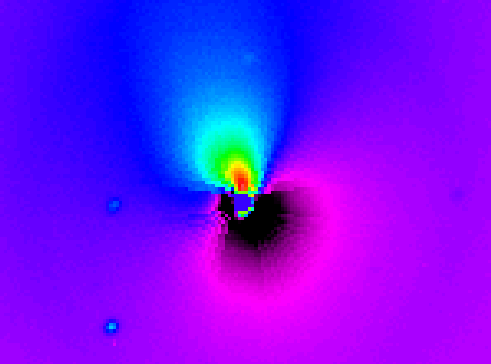Credit & Copyright: European Southern Observatory
Explanation:
Approaching the inner Solar System,
comet Hale-Bopp's icy nucleus is
heated by sunlight, accelerating its production of dust and gas.
Shrouded in the resulting cloud, known as the coma, the cometary nucleus
remains hidden from direct view. However, astronomers using a 2.2 meter
telescope at the European Southern Observatory in May,
were able to detect an enormous jet of dust
extending northward (up) from the nuclear region as seen in
this false color image.
Dust jets may arise from vents on the surface of the nucleus.
Early estimates of the size
of Hale-Bopp's nucleus have indicated that it could be as large as
40 kilometers (24 miles) in diameter -- several times larger
than comet Halley's.
Hale-Bopp's copious dust production
bodes well for it becoming a
bright naked-eye comet in the spring of 1997.
1999 2000 2001 2002 2003 2004 2005 2006 2007 2008 2009 2010 2011 2012 2013 2014 2015 2016 2017 2018 2019 2020 2021 2022 2023 2024 2025 |
Yanvar' Fevral' Mart Aprel' Mai Iyun' Iyul' Avgust Sentyabr' Oktyabr' Noyabr' Dekabr' |
NASA Web Site Statements, Warnings, and Disclaimers
NASA Official: Jay Norris. Specific rights apply.
A service of: LHEA at NASA / GSFC
& Michigan Tech. U.
|
Publikacii s klyuchevymi slovami:
strui - kometa Heila-Boppa - yadro komety
Publikacii so slovami: strui - kometa Heila-Boppa - yadro komety | |
Sm. takzhe:
Vse publikacii na tu zhe temu >> | |
